What Trait Is Shared By Animals And Fungi?
Fungi
121 Characteristics of Fungi
Learning Objectives
By the cease of this section, you will be able to practise the following:
- List the characteristics of fungi
- Describe the limerick of the mycelium
- Draw the mode of nutrition of fungi
- Explain sexual and asexual reproduction in fungi
Although humans take used yeasts and mushrooms since prehistoric times, until recently, the biological science of fungi was poorly understood. In fact, upward until the mid-20th century, many scientists classified fungi as plants! Fungi, like plants, are mostly sessile and seemingly rooted in place. They possess a stem-like construction similar to plants, besides as having a root-like fungal mycelium in the soil. In addition, their style of nutrition was poorly understood. Progress in the field of fungal biology was the upshot of mycology: the scientific study of fungi. Based on fossil bear witness, fungi appeared in the pre-Cambrian era, almost 450 million years ago. Molecular biology assay of the fungal genome demonstrates that fungi are more closely related to animals than plants. Under some current systematic phylogenies, they proceed to be a polyphyletic group of organisms that share characteristics, rather than sharing a single common antecedent.
Career Connexion
Mycologists are biologists who study fungi. Historically, mycology was a branch of microbiology, and many mycologists outset their careers with a degree in microbiology. To get a mycologist, a bachelor'southward degree in a biological science (preferably majoring in microbiology) and a primary's degree in mycology are minimally necessary. Mycologists can specialize in taxonomy and fungal genomics, molecular and cellular biology, institute pathology, biotechnology, or biochemistry. Some medical microbiologists concentrate on the study of infectious diseases caused by fungi, chosen mycoses. Mycologists collaborate with zoologists and plant pathologists to identify and control difficult fungal infections, such every bit the devastating chestnut blight, the mysterious decline in frog populations in many areas of the earth, or the mortiferous epidemic called white nose syndrome, which is decimating bats in the Eastern The states.
Government agencies rent mycologists as research scientists and technicians to monitor the wellness of crops, national parks, and national forests. Mycologists are as well employed in the private sector by companies that develop chemic and biological control products or new agricultural products, and past companies that provide illness control services. Because of the central role played by fungi in the fermentation of alcohol and the preparation of many important foods, scientists with a skilful understanding of fungal physiology routinely work in the food applied science industry. Oenology, the science of vino making, relies not just on the noesis of grape varietals and soil composition, merely also on a solid understanding of the characteristics of the wild yeasts that thrive in different vino-making regions. It is possible to buy yeast strains isolated from specific grape-growing regions. The corking French chemist and microbiologist, Louis Pasteur, made many of his essential discoveries working on the apprehensive brewer's yeast, thus discovering the process of fermentation.
Cell Structure and Part
Fungi are eukaryotes, and every bit such, have a complex cellular organization. As eukaryotes, fungal cells contain a membrane-leap nucleus. The Deoxyribonucleic acid in the nucleus is wrapped around histone proteins, as is observed in other eukaryotic cells. A few types of fungi accept accompaniment genomic structures comparable to bacterial plasmids (loops of DNA); however, the horizontal transfer of genetic information that occurs between 1 bacterium and another rarely occurs in fungi. Fungal cells also contain mitochondria and a complex system of internal membranes, including the endoplasmic reticulum and Golgi apparatus.
Dissimilar plant cells, fungal cells practice not have chloroplasts or chlorophyll. Many fungi brandish bright colors arising from other cellular pigments, ranging from red to green to black. The poisonous Amanita muscaria (fly agaric) is recognizable by its bright red cap with white patches ((Figure)). Pigments in fungi are associated with the cell wall and play a protective office against ultraviolet radiation. Some fungal pigments are toxic to humans.
Amanita. The poisonous Amanita muscaria is native to temperate and boreal regions of North America. (credit: Christine Majul)
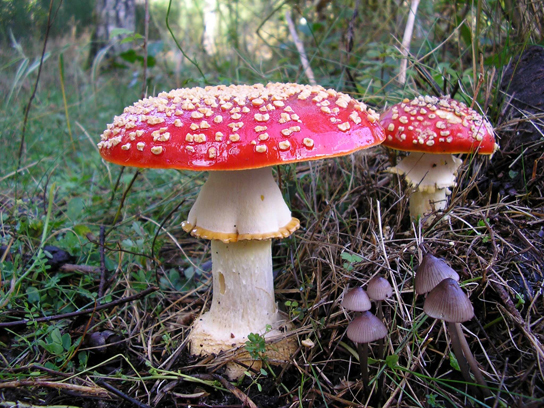
Similar plant cells, fungal cells have a thick jail cell wall. The rigid layers of fungal prison cell walls contain complex polysaccharides called chitin and glucans. Chitin (N-acetyl-D-glucosamine), besides found in the exoskeleton of arthropods such as insects, gives structural strength to the cell walls of fungi. The wall protects the cell from desiccation and some predators. Fungi take plasma membranes similar to those of other eukaryotes, except that the construction is stabilized by ergosterol: a steroid molecule that replaces the cholesterol found in fauna jail cell membranes. Almost members of the kingdom Fungi are nonmotile. However, flagella are produced by the spores and gametes in the primitive Phylum Chytridiomycota.
Growth
The vegetative body of a fungus is a unicellular or multicellular thallus. Unicellular fungi are chosen yeasts. Multicellular fungi produce threadlike hyphae (singular hypha). Dimorphic fungi tin can change from the unicellular to multicellular country depending on environmental conditions. Saccharomyces cerevisiae (baker'due south yeast) and Candida species (the agents of thrush, a common fungal infection) are examples of unicellular fungi ((Effigy)).
Candida albicans. Candida albicans is a yeast cell and the agent of candidiasis and thrush. This organism has a like morphology to coccus bacteria; however, yeast is a eukaryotic organism (annotation the nucleus). (credit: modification of work by Dr. Godon Roberstad, CDC; scale-bar data from Matt Russell)
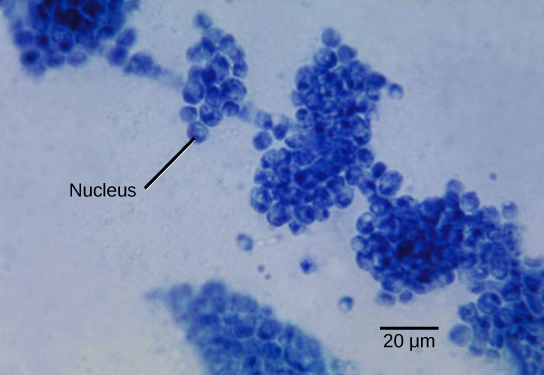
Most fungi are multicellular organisms. They display two distinct morphological stages: the vegetative and reproductive. The vegetative stage consists of a tangle of hyphae, whereas the reproductive stage tin can exist more than conspicuous. The mass of hyphae is a mycelium ((Figure)). It can grow on a surface, in soil or decaying textile, in a liquid, or even on living tissue. Although private hyphae must be observed under a microscope, the mycelium of a fungus can be very large, with some species truly being "the fungus humongous." The giant Armillaria solidipes (honey mushroom) is considered the largest organism on Earth, spreading across more two,000 acres of underground soil in eastern Oregon; it is estimated to be at to the lowest degree 2,400 years old.
A fungal mycelium. The mycelium of the fungus Neotestudina rosati can be pathogenic to humans. The fungus enters through a cut or scrape and develops a mycetoma, a chronic subcutaneous infection. (credit: CDC)

Near fungal hyphae are divided into carve up cells by endwalls called septa (singular, septum) ((Effigy)a, c). In most phyla of fungi, tiny holes in the septa let for the rapid flow of nutrients and small molecules from cell to cell along the hypha. They are described as perforated septa. The hyphae in bread molds (which belong to the Phylum Zygomycota) are non separated past septa. Instead, they are formed by large cells containing many nuclei (multinucleate), an organisation described as coenocytic hyphae ((Figure)b).
Fungal hyphae. Fungal hyphae may be (a) septated or (b) coenocytic (coeno- = "common"; -cytic = "cell") with many nuclei present in a single hypha. A bright field light micrograph of (c) Phialophora richardsiae shows septa that carve up the hyphae. (credit c: modification of work by Dr. Lucille Georg, CDC; scale-bar data from Matt Russell)
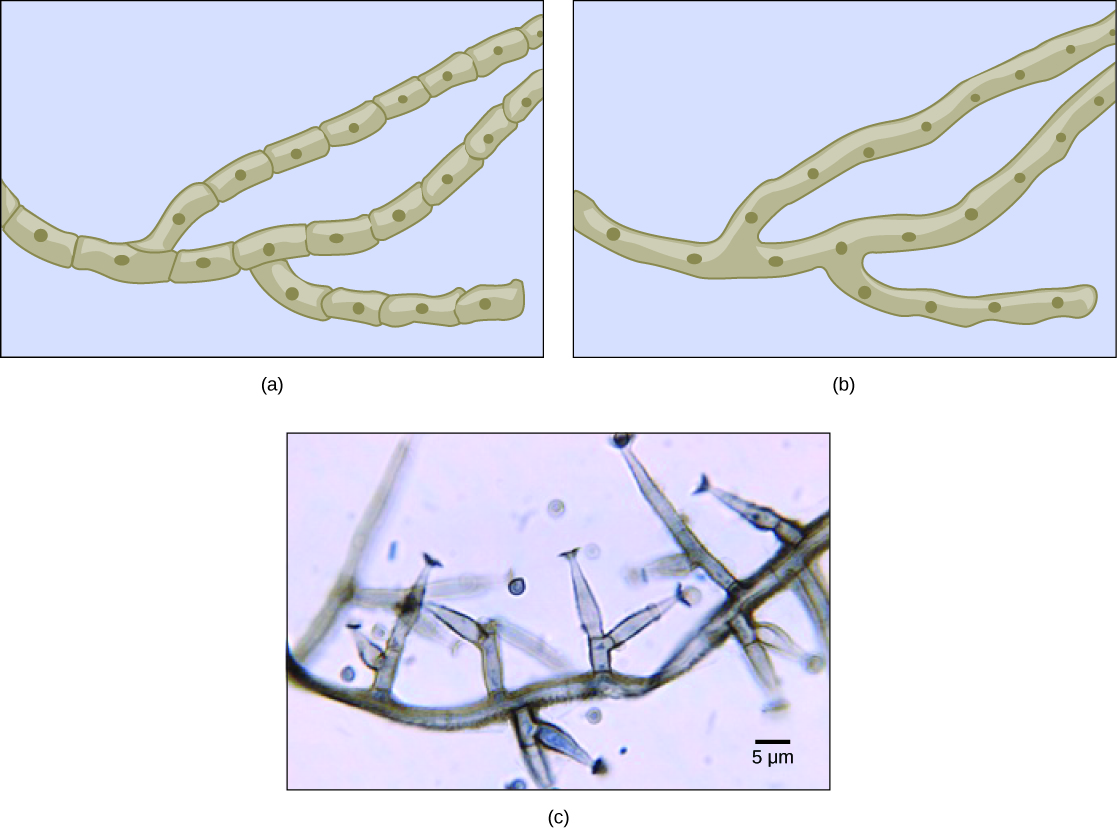
Fungi thrive in environments that are moist and slightly acidic, and can grow with or without lite. They vary in their oxygen requirement. Most fungi are obligate aerobes, requiring oxygen to survive. Other species, such equally members of the Chytridiomycota that reside in the rumen of cattle, are obligate anaerobes, in that they only use anaerobic respiration considering oxygen will disrupt their metabolism or kill them. Yeasts are intermediate, being facultative anaerobes. This means that they grow best in the presence of oxygen using aerobic respiration, but can survive using anaerobic respiration when oxygen is not available. The alcohol produced from yeast fermentation is used in vino and beer production.
Nutrition
Like animals, fungi are heterotrophs; they utilize complex organic compounds as a source of carbon, rather than fix carbon dioxide from the temper as do some bacteria and most plants. In addition, fungi practise non prepare nitrogen from the atmosphere. Like animals, they must obtain it from their diet. However, dissimilar most animals, which ingest food and then digest it internally in specialized organs, fungi perform these steps in the reverse society; digestion precedes ingestion. First, exoenzymes are transported out of the hyphae, where they process nutrients in the environs. Then, the smaller molecules produced by this external digestion are captivated through the big surface area of the mycelium. As with animal cells, the polysaccharide of storage is glycogen, a branched polysaccaride, rather than amylopectin, a less densely branched polysaccharide, and amylose, a linear polysaccharide, as found in plants.
Fungi are mostly saprobes (saprophyte is an equivalent term): organisms that derive nutrients from decaying organic matter. They obtain their nutrients from expressionless or decomposing organic material derived mainly from plants. Fungal exoenzymes are able to suspension downwards insoluble compounds, such equally the cellulose and lignin of expressionless wood, into readily absorbable glucose molecules. The carbon, nitrogen, and other elements are thus released into the environment. Considering of their varied metabolic pathways, fungi fulfill an important ecological office and are existence investigated every bit potential tools in bioremediation of chemically damaged ecosystems. For example, some species of fungi can be used to break down diesel oil and polycyclic aromatic hydrocarbons (PAHs). Other species accept up heavy metals, such equally cadmium and lead.
Some fungi are parasitic, infecting either plants or animals. Smut and Dutch elm disease bear upon plants, whereas athlete's human foot and candidiasis (thrush) are medically important fungal infections in humans. In environments poor in nitrogen, some fungi resort to predation of nematodes (small non-segmented roundworms). In fact, species of Arthrobotrys fungi have a number of mechanisms to trap nematodes: One mechanism involves constricting rings within the network of hyphae. The rings corking when they touch on the nematode, gripping it in a tight hold. The mucus and so penetrates the tissue of the worm past extending specialized hyphae called haustoria. Many parasitic fungi possess haustoria, as these structures penetrate the tissues of the host, release digestive enzymes within the host's body, and absorb the digested nutrients.
Reproduction
Fungi reproduce sexually and/or asexually. Perfect fungi reproduce both sexually and asexually, while the so-chosen imperfect fungi reproduce simply asexually (by mitosis).
In both sexual and asexual reproduction, fungi produce spores that disperse from the parent organism by either floating on the current of air or hitching a ride on an animal. Fungal spores are smaller and lighter than plant seeds. For example, the giant puffball mushroom bursts open up and releases trillions of spores in a massive deject of what looks similar finely particulate dust. The huge number of spores released increases the likelihood of landing in an environment that volition back up growth ((Figure)).
Puffball and spores. The (a) behemothic puffball mushroom releases (b) a cloud of spores when it reaches maturity. (credit a: modification of work past Roger Griffith; credit b: modification of work by Pearson Scott Foresman, donated to the Wikimedia Foundation)
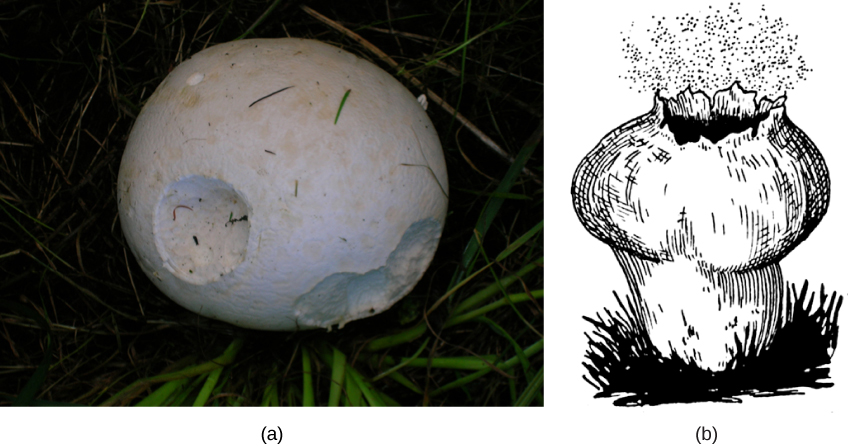
Asexual Reproduction
Fungi reproduce asexually past fragmentation, budding, or producing spores. Fragments of hyphae can grow new colonies. Somatic cells in yeast form buds. During budding (an expanded type of cytokinesis), a bulge forms on the side of the cell, the nucleus divides mitotically, and the bud ultimately detaches itself from the mother jail cell ((Figure)).
Budding in Histoplasma. The dark cells in this bright field low-cal micrograph are the pathogenic yeast Histoplasma capsulatum, seen against a backdrop of low-cal blueish tissue. Histoplasma primarily infects lungs but can spread to other tissues, causing histoplasmosis, a potentially fatal disease. (credit: modification of work by Dr. Libero Ajello, CDC; scale-bar information from Matt Russell)
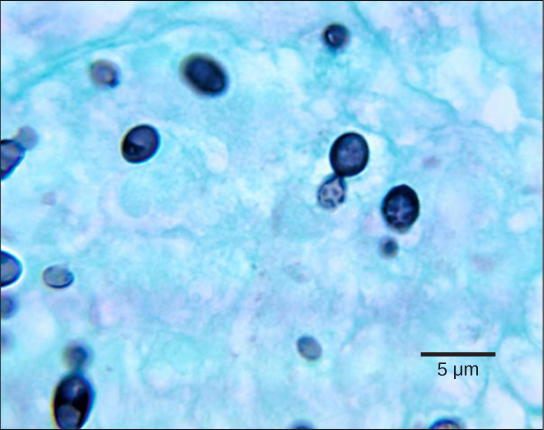
The most common way of asexual reproduction is through the germination of asexual spores, which are produced by a single private thallus (through mitosis) and are genetically identical to the parent thallus ((Figure)). Spores let fungi to expand their distribution and colonize new environments. They may be released from the parent thallus either outside or within a special reproductive sac called a sporangium.
Generalized fungal life cycle. Fungi may accept both asexual and sexual stages of reproduction.
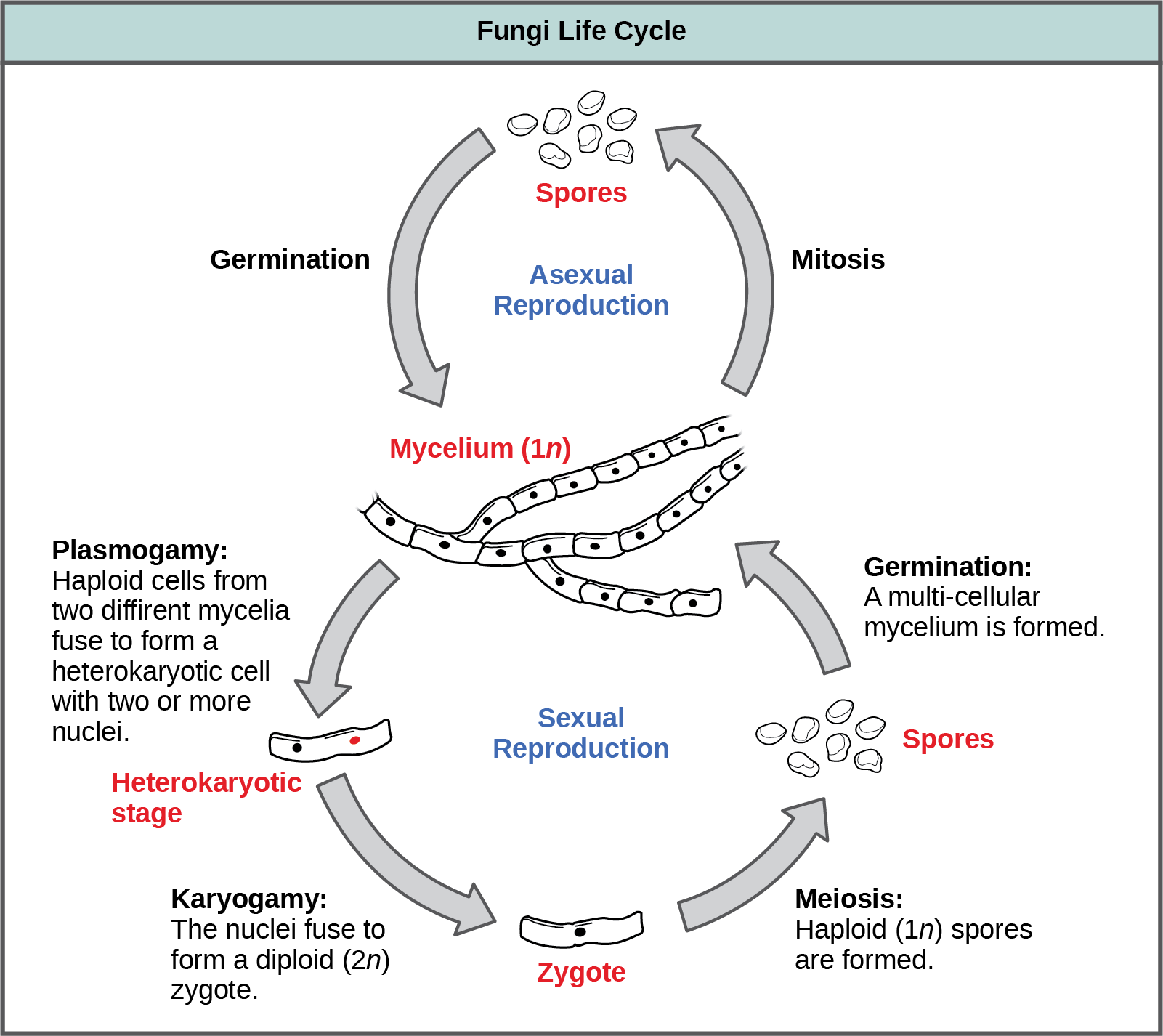
In that location are many types of asexual spores. Conidiospores are unicellular or multicellular spores that are released directly from the tip or side of the hypha. Other asexual spores originate in the fragmentation of a hypha to grade single cells that are released every bit spores; some of these have a thick wall surrounding the fragment. Yet others bud off the vegetative parent cell. In dissimilarity to conidiospores, sporangiospores are produced directly from a sporangium ((Effigy)).
Sporangiospores. This bright field light micrograph shows the release of spores from a sporangium at the finish of a hypha called a sporangiophore. The organism is a Mucor sp. fungus, a mold ofttimes constitute indoors. (credit: modification of work by Dr. Lucille Georg, CDC; scale-bar information from Matt Russell)
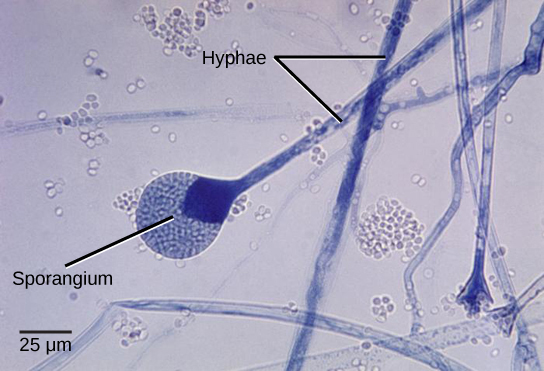
Sexual Reproduction
Sexual reproduction introduces genetic variation into a population of fungi. In fungi, sexual reproduction ofttimes occurs in response to agin ecology conditions. During sexual reproduction, 2 mating types are produced. When both mating types are present in the same mycelium, it is called homothallic, or self-fertile. Heterothallic mycelia require 2 unlike, merely uniform, mycelia to reproduce sexually.
Although there are many variations in fungal sexual reproduction, all include the post-obit three stages ((Figure)). First, during plasmogamy (literally, "union or union of cytoplasm"), 2 haploid cells fuse, leading to a dikaryotic stage where two haploid nuclei coexist in a single jail cell. During karyogamy ("nuclear wedlock"), the haploid nuclei fuse to form a diploid zygote nucleus. Finally, meiosis takes place in the gametangia (singular, gametangium) organs, in which gametes of dissimilar mating types are generated. At this stage, spores are disseminated into the environment.
Link to Learning
Review the characteristics of fungi by visiting this interactive site from Wisconsin-online.
Section Summary
Fungi are eukaryotic organisms that appeared on state more than 450 million years agone, just clearly have an evolutionary history far greater. They are heterotrophs and incorporate neither photosynthetic pigments such equally chlorophyll, nor organelles such as chloroplasts. Because fungi feed on decaying and expressionless matter, they are termed saprobes. Fungi are important decomposers that release essential elements into the environment. External enzymes chosen exoenzymes digest nutrients that are captivated by the body of the mucus, which is called a thallus. A thick cell wall fabricated of chitin surrounds the cell. Fungi can exist unicellular as yeasts, or develop a network of filaments chosen a mycelium, which is oft described every bit mold. Most species multiply by asexual and sexual reproductive cycles and brandish an alternation of generations. In ane group of fungi, no sexual cycle has been identified. Sexual reproduction involves plasmogamy (the fusion of the cytoplasm), followed by karyogamy (the fusion of nuclei). Following these processes, meiosis generates haploid spores.
Review Questions
Which polysaccharide is usually found in the prison cell wall of fungi?
- starch
- glycogen
- chitin
- cellulose
C
Which of these organelles is non found in a fungal cell?
- chloroplast
- nucleus
- mitochondrion
- Golgi apparatus
A
The wall dividing individual cells in a fungal filament is chosen a
- thallus
- hypha
- mycelium
- septum
D
During sexual reproduction, a homothallic mycelium contains
- all septated hyphae
- all haploid nuclei
- both mating types
- none of the above
C
The life cycles of perfect fungi are near similar to which other organism?
- Hydra that undergo asexual budding
- Diploid-dominant pea plants
- Haploid-dominant dark-green algae
- Bacteria undergoing binary fission
C
Critical Thinking Questions
What are the evolutionary advantages for an organism to reproduce both asexually and sexually?
Asexual reproduction is fast and best under favorable conditions. Sexual reproduction allows the recombination of genetic traits and increases the odds of developing new adaptations better suited to a changed environment.
Compare plants, animals, and fungi, because these components: cell wall, chloroplasts, plasma membrane, food source, and polysaccharide storage. Be sure to indicate fungi's similarities and differences to plants and animals.
Animals have no cell walls; fungi have cell walls containing chitin; plants have cell walls containing cellulose. Chloroplasts are absent in both animals and fungi but are present in plants. Animal plasma membranes are stabilized with cholesterol, while fungi plasma membranes are stabilized with ergosterol, and plant plasma membranes are stabilized with phytosterols. Animals obtain Northward and C from food sources via internal digestion. Fungi obtain Due north and C from nutrient sources via external digestion. Plants obtain organic North from the environment or through symbiotic Due north-fixing bacteria; they obtain C from photosynthesis. Animals and fungi store polysaccharides as glycogen, while plants shop them equally starch.
Why is the large surface area of the mycelium essential for nutrient acquisition by fungi?
Fungi interruption downward decaying matter in their environment to serve as their food source. Since the digestion occurs externally, the large mycelium tin secrete exoenzymes over a big surface area. The fungi must be able to absorb the small-scale molecules released by digestion, then having a big surface area increases the amount of digested molecules that are captured past the fungi.
Glossary
- coenocytic hypha
- unmarried hypha that lacks septa and contains many nuclei
- facultative anaerobes
- organisms that can perform both aerobic and anaerobic respiration and can survive in oxygen-rich and oxygen-poor environment
- haustoria
- modified hyphae on many parasitic fungi that penetrate the tissues of their hosts, release digestive enzymes, and/or blot nutrients from the host
- heterothallic
- describes when but one mating type is nowadays in an individual mycelium
- homothallic
- describes when both mating types are present in mycelium
- hypha
- fungal filament composed of one or more cells
- karyogamy
- fusion of nuclei
- mycelium
- mass of fungal hyphae
- mycology
- scientific study of fungi
- obligate aerobes
- organisms, such as humans, that must perform aerobic respiration to survive
- obligate anaerobes
- organisms that only perform anaerobic respiration and frequently cannot survive in the presence of oxygen
- plasmogamy
- fusion of cytoplasm
- saprobe
- organism that derives nutrients from decaying organic matter; also saprophyte
- septa
- jail cell wall sectionalization between hyphae
- sporangium
- reproductive sac that contains spores
- thallus
- vegetative body of a mucus
- yeast
- general term used to describe unicellular fungi
Source: https://opentextbc.ca/biology2eopenstax/chapter/characteristics-of-fungi/
Posted by: gentilelovent.blogspot.com

0 Response to "What Trait Is Shared By Animals And Fungi?"
Post a Comment